2017中考英语语法易错易混知识点汇总
2017中考英语语法易错易混知识点集锦(十一)
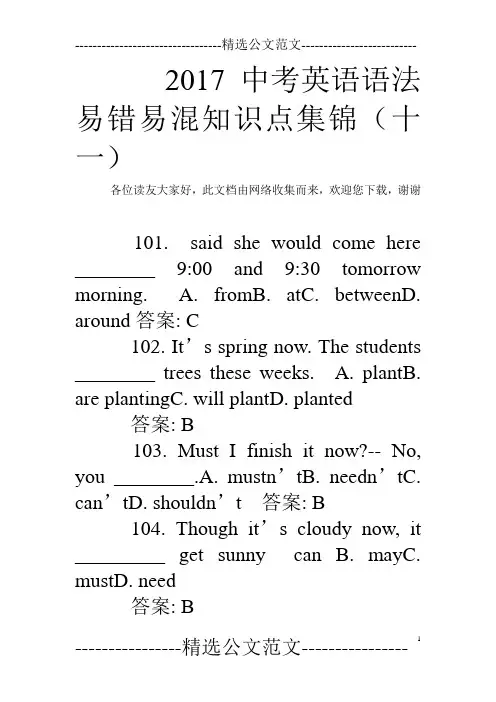
2017中考英语语法易错易混知识点集锦(十一)各位读友大家好,此文档由网络收集而来,欢迎您下载,谢谢101. said she would come here ________ 9:00 and 9:30 tomorrow morning. A. fromB. atC. betweenD. around答案: C102. It’s spring now. The students ________ trees these weeks. A. plantB. are plantingC. will plantD. planted答案: B103. Must I finish it now?-- No, you ________.A. mustn’tB. needn’tC. can’tD. shouldn’t答案: B104. Though it’s cloudy now, it _________ get sunny can B. mayC. mustD. need答案: B105. It is in the library, you _______ talk may notB. can’tC. needn’tD. mustn’t答案: D106. If anyone wants to say something in class, you ________ put up your hands first. A. mustB. mayC. shouldD. can答案: A107. –I called you last night but no one answered the phone.-- I ________ dinner with my friends in the restaurant.A. haveB. hadC. was havingD. have had答案:C108. If you have lost a library book, you have to _________ it. A. find outB. look afterC. pay forD. take care答案:C109. He will call me as soon as he _________ the reachesB. reachedC. will reachD. is reaching答案:A110. The pen _________ him tenpaidB. costC. tookD. spent答案:B各位读友大家好,此文档由网络收集而来,欢迎您下载,谢谢。
中考英语78个易混易错单词+短语+句型(全)
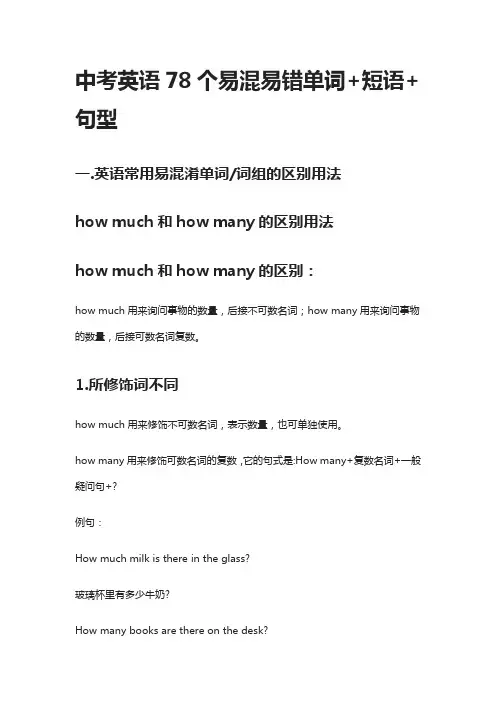
中考英语78个易混易错单词+短语+句型一.英语常用易混淆单词/词组的区别用法how much和how many的区别用法how much和how many的区别:how much用来询问事物的数量,后接不可数名词;how many用来询问事物的数量,后接可数名词复数。
1.所修饰词不同how much用来修饰不可数名词,表示数量,也可单独使用。
how many用来修饰可数名词的复数,它的句式是:How many+复数名词+一般疑问句+?例句:How much milk is there in the glass?玻璃杯里有多少牛奶?How many books are there on the desk?有多少本书在桌子上?2.用法不同How much 表示多少钱,用来问价格。
例句:How much is this dress?这个连衣裙多少钱?How many 表示多少,用来问数量。
例句:How many apples do you have?你有多少苹果?in和on的区别用法:当我们表示某些东西被其他东西所包围时使用“in”这个词。
而“on”用于描述物体被放置在其他物体上方或外部的情况。
in可表时间,表地点,表手段、方法、材料。
on表示时间、地点、方位等。
1.意思不同in:prep.在 ... 里;在 ... 地方;在 ... 期间on:prep.在 ... 之上2.用法不同in:in着重一段时间的过程,常用于重复动作或延续动作。
in表示从现在时间算起推移到将来的一段时间之后,一般与将来时态连用。
He is a layman in economics.他对经济学一窍不通。
on:表示“在物体的表面上”,只能用on的表达方式有on the next morning,on the following。
The spider is walking on the ceiling.蜘蛛在天花板上爬行。
3.侧重点不同in:表示“在其中”。
2017中考英语语法易错易混知识点(四)
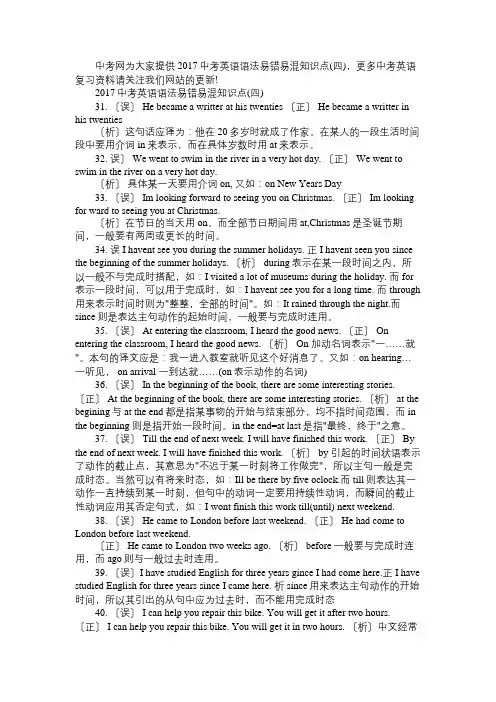
中考网为大家提供2017中考英语语法易错易混知识点(四),更多中考英语复习资料请关注我们网站的更新!2017中考英语语法易错易混知识点(四)31. 〔误〕 He became a writter at his twenties 〔正〕 He became a writter in his twenties〔析〕这句话应译为:他在20多岁时就成了作家。
在某人的一段生活时间段中要用介词in来表示,而在具体岁数时用at来表示。
32. 误〕 We went to swim in the river in a very hot day. 〔正〕 We went to swim in the river on a very hot day.〔析〕具体某一天要用介词on, 又如:on New Years Day33. 〔误〕 Im looking forward to seeing you on Christmas. 〔正〕 Im looking for ward to seeing you at Christmas.〔析〕在节日的当天用on,而全部节日期间用at,Christmas是圣诞节期间,一般要有两周或更长的时间。
34. 误 I havent see you during the summer holidays. 正 I havent seen you since the beginning of the summer holidays. 〔析〕 during表示在某一段时间之内,所以一般不与完成时搭配,如:I visited a lot of museums during the holiday. 而for 表示一段时间,可以用于完成时,如:I havent see you for a long time. 而through 用来表示时间时则为"整整,全部的时间"。
如:It rained through the night.而since则是表达主句动作的起始时间,一般要与完成时连用。
2017年中考英语语法难点汇总文库.doc
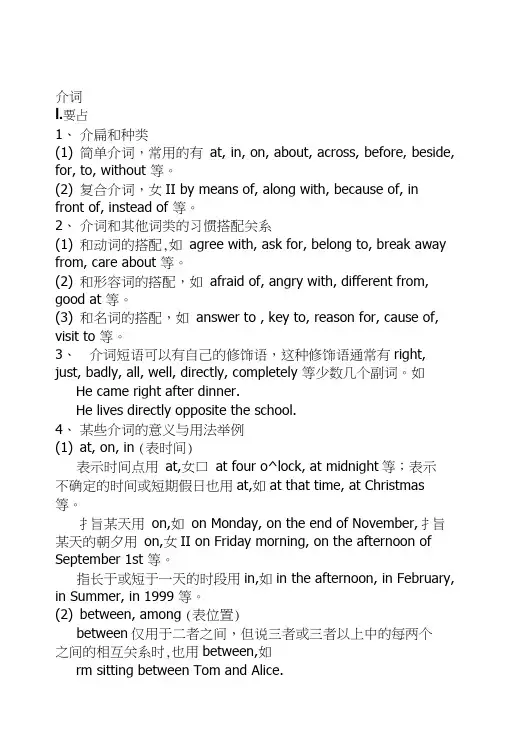
介词I.要占1、介扁和种类(1)简单介词,常用的有at, in, on, about, across, before, beside, for, to, without 等。
(2)复合介词,女II by means of, along with, because of, in front of, instead of 等。
2、介词和其他词类的习惯搭配关系(1)和动词的搭配,如agree with, ask for, belong to, break away from, care about 等。
(2)和形容词的搭配,如afraid of, angry with, different from, good at 等。
(3)和名词的搭配,如answer to , key to, reason for, cause of, visit to 等。
3、介词短语可以有自己的修饰语,这种修饰语通常有right, just, badly, all, well, directly, completely 等少数几个副词。
如He came right after dinner.He lives directly opposite the school.4、某些介词的意义与用法举例(1)at, on, in (表时间)表示时间点用at,女口at four o^lock, at midnight等;表示不确定的时间或短期假日也用at,如at that time, at Christmas等。
扌旨某天用on,如on Monday, on the end of November,扌旨某天的朝夕用on,女II on Friday morning, on the afternoon of September 1st 等。
指长于或短于一天的时段用in,如in the afternoon, in February, in Summer, in 1999 等。
中考英语语法易错易混知识点

中考英语语法易错易混知识点一、可数名词与不可数名词1.可数名词表示能够用数目表示的名词,常常可以用单数或复数形式来表示,其前可以加"a"或"an"。
例句:I have a book.(单数)/ I have two books.(复数)2.不可数名词表示不能用数目清楚地表示的名词,只能用单数形式,前面不能加"a"或"an"。
例句:I have some milk.(不可数名词)二、形容词与副词1.形容词修饰名词,用来描述或限定名词。
形容词通常放在名词的前面。
例句:She is a beautiful girl.2.副词用来修饰动词、形容词或其他副词,通常放在被修饰词的后面。
例句:He runs fast.三、一般现在时与现在进行时1.一般现在时表示经常性或习惯性的动作,叙述真理或客观事实。
例句:The sun rises in the east.(真理)/ He often plays soccer on weekends.(习惯性动作)2.现在进行时表示现在正在进行的动作。
例句:I am watching TV now.(正在进行的动作)四、一般过去时与过去进行时1.一般过去时表示已经结束的过去的动作。
例句:I finished my homework yesterday.(过去的动作已经完成)2.过去进行时表示过去其中一时刻正在进行的动作。
例句:They were playing basketball at 7 o'clock yesterday evening.(过去其中一时刻正在进行的动作)五、定冠词与不定冠词1.定冠词"the"用来特指已经提到过或可唯一确定的名词。
例句:I saw the boy in the park.(特指已经提到的男孩)2.不定冠词"a"或"an"用来表示泛指或不特指的名词。
2017中考英语语法易错易混知识点集锦(十四)
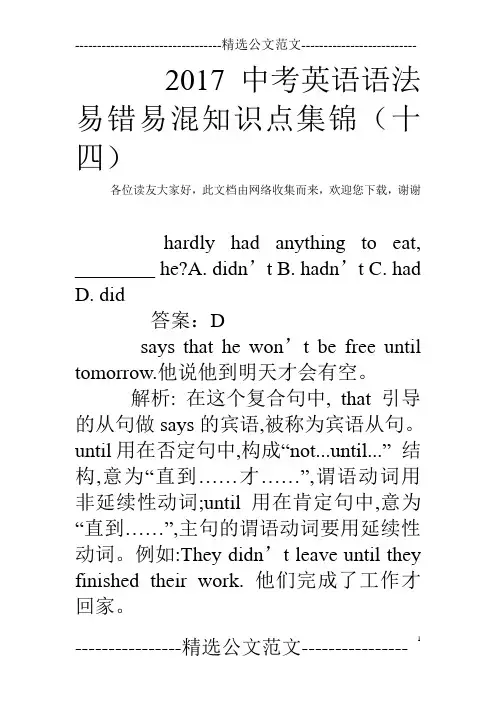
2017中考英语语法易错易混知识点集锦(十四)各位读友大家好,此文档由网络收集而来,欢迎您下载,谢谢hardly had anything to eat, ________ he?A. didn’t B. hadn’t C. had D. did答案:Dsays that he won’t be free until tomorrow.他说他到明天才会有空。
解析: 在这个复合句中, that引导的从句做says的宾语,被称为宾语从句。
until用在否定句中,构成“not...until...” 结构,意为“直到……才……”,谓语动词用非延续性动词;until用在肯定句中,意为“直到……”,主句的谓语动词要用延续性动词。
例如:They didn’t leave until they finished their work. 他们完成了工作才回家。
We waited until he came. 我们一直等到他来。
133. 课本:There’s something wrong with my computer. It doesn’t work. 我的计算机出了故障,它无法工作了。
真题再现:I have to speak to my grandpa loudly because there’s _____ with his ears.A. wrong somethingB. something wrongC. anything wrongD. nothing wrong要点点拨:形容词修饰something, nothing, anything, everything等不定代词时要后置,故排除A。
答案:B134.课本原句:All the computers must be shut down when you leave. 离开时你必须把所有的计算机关掉。
真题:The whole company _____ for a three weeks’summer holiday. A. shut down B. shut off C. shut up D. shut away要点点拨:shut down意为“关闭;停工;歇业”;shut off意为“关掉”等;shut up意为“关闭;住嘴”等;shut away意为“隔离;隔绝”。
2017年中考英语语法易错易混知识点集锦(十六)
2017年中考英语语法易错易混知识点集锦(十六)151. I learned that her father ____ in 1950.A had died B died C dead D is dead解析:该题正确答案为B。
从句中的谓语动词动作虽然发生在主句谓语动词的动作之前,但因从句中有明确的过去时间状语in 1950, 所以不用过去完成时态,而用一般过去时态。
152. The five-year-old girl ____ by her parents. A is looked B has looked forC is being looked for D has been looked解析:该题正确答案为C。
在带有介词的动词短语用于被动语态句中,介词不能省,否则就变成了不及物动词短语,而不能用于被动语态的句子中。
153. We had hoped that he ____ longer.A stays B have stayed C stayed D would stay解析:该题正确答案为D。
had hoped表示"本希望",同样用法的动词还有think, expect等,后面的句子需用虚拟语气154. "Mary wants to see you today"."I would rather she ____ tomorrow than today." A comes B came C should come D will come解析:该题正确答案为B。
would rather后面的从句需用虚拟语气,用动词过去时表示。
155. It is wise to have some money ____ for old age.A put away B kept up C given away D laid up解析:该题正确答案为A。
2017年中考英语语法易错易混知识点汇总(18)
2017年中考英语语法易错易混知识点汇总(18)171. The bus ____C__ on the road for 2 hours so far. A. has stopped B. stopped C. has beenAre you __A___ the jacket these days? A. wearing B. putting on C. dressing D. onHe __C______ foe 2 hours. A. got up B. has got up C. has been upYou mustn't ___B_____ until he comes back. A. be away B. leave C. be left 172. —These farmers have been to the United States. —Really ? When _____ there ?A. will they goB. did they goC. do they goD. have they gone现在完成时与一般过去时容易混淆,就是因为它们所表示的动作都发生在过去,但二者又有区别:一般过去时表示过去某个时间发生的事、存在的状态或经常发生的动作,说话的侧重点在于陈述一件过去的事情,与现在没有关系;现在完成时表示与现在有关系的发生在过去的动作,它不与表示过去的时间状语(如yesterday , last week , a moment ago等)连用。
故9的正确答案为B.173. His father ______ the Party since 1978.A. joined B. has joined C. was in D. has been in 现在完成时中,非延续性动词不能与for和since引导的表示一段时间的状语连用,通常是用相应的延续性动词来代替。
2017中考英语语法易错易混知识点(六)
2017中考英语语法易错易混知识点(六)中考网为大家提供2017中考英语语法易错易混知识点(六),更多中考英语复习资料请关注我们网站的更新!2017中考英语语法易错易混知识点(六)1. 〔误〕 I didnt do my homework, so the teacher was angry to me. 〔正〕 I didnt do my homework, so the teacher was angry with me. 〔析〕 be angry with其后接人,而be angry at其后接事。
如:He was angry at what she said.2. 〔误〕 He was good for skating. 〔正〕 He was good at skating.〔析〕 be good at 为"擅长某事",而be good for somebody 为对某人很好。
3. 〔误〕 It was good to you to help my little boy. 〔正〕 It was good of you to help my little boy.〔析〕这句话应译为:你真太好了,帮助了我的小孩。
而be good to somebody 是对某人态度好。
如:Her mother is good to everyone.4. 〔误〕My parents were very pleased at me. 〔正〕My parents were very pleased with me. 〔正〕 My parents were very pleased at my studying. 〔析〕 be pleased with后加somebody, 而be pleased at后加something。
5. 〔误〕 He is agree with me. 〔正〕 He agrees with me. 〔误〕He againsts me. 〔正〕 He is against me.〔析〕同意agree为动词,而反对against则为介词。
2017中考英语语法易错易混知识点集锦(十)
2017中考英语语法易错易混知识点集锦(十)各位读友大家好,此文档由网络收集而来,欢迎您下载,谢谢91. I’m going to look for another job ________ the company offers me more afterB. unlessC. whenD. for答案: B92. Don’t hurry. The bus won’t start ________ everybody gets sinceB. asC. untilD. when答案: C93. .Please show me ____to send an e-mail, John. It’s the first time for me to do it. A. howB. whatC. whenD. where 答案:A94. You’ve passed the exam. I’m happy ______ onB. atC. inD. for答案:D95. I wonder ________ they finished so many different jobs in such a shortwhyB. howC. whenD. where答案:B96. -- Do you speak English?-- Yes, I speak _________ a little English _______ some French.A. neither, notB. both, orC. either, orD. not only, but also答案:D97. .______ the maths problem is difficult, I’ll try very hard to work it ThoughB. WhenC. BeforeD. After答案:A98. The accident took place ________a cold February onB. inC. atD. for答案:A99. He turned ________ the radio because his father was asleep. A. onB. downC. upD. over答案:B100. I don’t know the homework _______ today. A. onB. inC. ofD. for 答案:D各位读友大家好,此文档由网络收集而来,欢迎您下载,谢谢。
- 1、下载文档前请自行甄别文档内容的完整性,平台不提供额外的编辑、内容补充、找答案等附加服务。
- 2、"仅部分预览"的文档,不可在线预览部分如存在完整性等问题,可反馈申请退款(可完整预览的文档不适用该条件!)。
- 3、如文档侵犯您的权益,请联系客服反馈,我们会尽快为您处理(人工客服工作时间:9:00-18:30)。
2017中考英语语法易错易混知识点汇总(2)
11. Look! Here the bus comes.(×)
Look! Here comes the bus.(√)
[析] 在以here, there引起的陈述句中,若句子的主语是名词,要用倒装语序,即用“Here /There+动词+名词”结构;但主语若是代词时,则不用倒装
语序, 即用“Here/There +代词+动词”结构。
12. I do well in playing football, _______. (我妹妹也行。
)A. so
my sister does(×)B. so does my sister(√)
Li Lei is really a football fan. --- _______. (确实这样.) A. So
is he(×) B. So he is(√)
[析] “so+be动词/助动词+主语”的倒装结构表示前面所述情况也适用于
后者,意为“……也是这样”;“so+主语+be动词/助动词”的陈述结构表示对
前述情况的肯定,意为“……确实如此”。
13.重庆比中国的其他城市都大。
Chongqing is larger than any city in China. (×)Chongqing is
larger than any other city in China. (√)
[析] “any city in China”包括了重庆这座城市, 同一事物自己与自己
不能做比较,只有在city 前加上other才能表示重庆和中国的其它城市比较
大小。
The weather in Guangzhou is warmer than Beijing. (×)
The weather in Guangzhou is warmer than that in Beijing . (√)
[析] 表示比较时,句子中的两个比较对象必须一致,不同的比较对象不能做比较。
错误句的比较对象分别为the weather in Guangzhou和Beijing,这
两个不同类的事物之间不能做比较。
14, His sister married with a teacher last summer.(×)His sister married a teacher last summer. (√)
[析] 表达“A和B结婚”,要用A married/will marry B。
这时务必要避免受汉语影响使用A married/will marry with B。
15. 例There is going to have a film tonight. (×) There is going to be a film tonight. (√)
[析] 一般将来时用在 There be 句式中时,be going to或will之后的
动词原形只能用be,也就是说要用There is (are) going to be.... / There will be....。
16. 例I’ll go hiking if it won’t rain next Sunday. (×)I’ll
go hiking if it doesn’t rain next Sunday.(√)
[析] 习惯上在含有时间状语从句和条件状语从句的复合句中,如果主句的谓语动词用了一般将来时,从句的谓语动词要用一般现在时表示将来的动作。
17.例 Teacher told us yesterday that the earth went around the sun. (×)
Teacher told us yesterday that the earth goes around the sun. (√) [析] 习惯上在含有宾语从句的复合句中,主句的谓语动词用了一般过去
时,从句的谓语动词要用过去的某种时态。
但如果从句表述的是一客观事实或客观真理时,则不受主句时态的影响,而用一般现在时。
18. All the balls are not round. 翻译成汉语:
所有的球都不是圆的。
(×)并不是所有的球都是圆的。
(√)
[析] all, every, both等词和not连用时,not通常放在all, every, both的后面,一般情况下表示部分否定,意为“并非……都……”。
19. 例--- He didn’t go to school yesterday, did he?-- _______, though he didn’t feel very well.
A. No, he didn’t (×)
B. Yes, he did (√)
例--- Don’t you usually come to school by bike?-- _______. But I sometimes walk.
A. No, I don’t (×)
B. Yes, I do (√)
[析] 习惯上英语中的yes意为“是的”,no意为“不”,但在“前否后肯”的反意疑问句或否定疑问句中,yes意为“不”,no意为“是的”。
20.---- Excuse me, is the supermarket far from here?---- No,it's about _______.
A. 7 minutes walk
B. 7 minute walk
C. 7 minutes' walk
D. 7
minute's walk
答案为C。
本题考查名词所有格用法。
当名词的复数以-s结尾时,则只需要加“'”即可,则“7分钟的距离”为“7 minutes' walk”。
